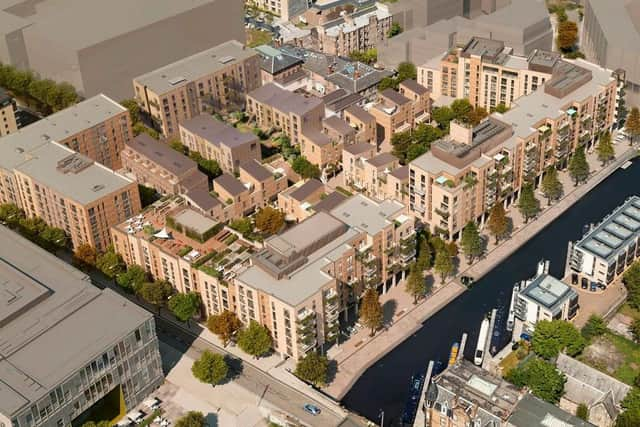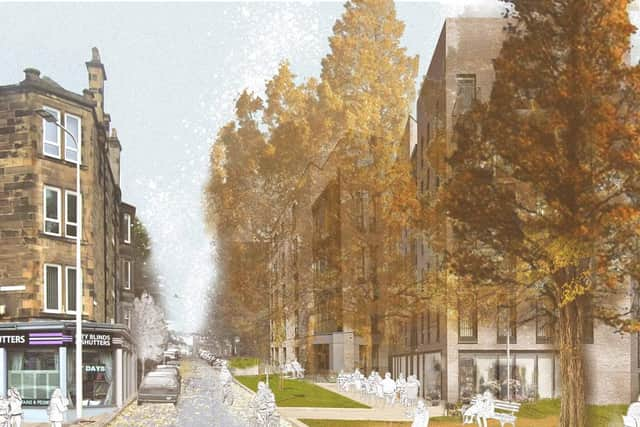Edinburgh Council to spend £2.5 billion building 10,000 new 'affordable' homes for the Capital
and live on Freeview channel 276
Council bosses are set to commit £2.5bn over the next decade in order to build thousands of new affordable homes and improve existing houses – labelled “one of the most ambitious” projects set to take place across the UK.
Edinburgh City Council’s housing, homelessness and fair work committee considered the proposed housing revenue account (HRA) strategy up to 2030 – which will be formally approved when the authority gives its budget the thumbs up next month. The authority’s £2.5bn proposals are thought to be one of the biggest house-building programmes by a local authority in Scotland, if not the UK.
Advertisement
Hide AdAdvertisement
Hide AdA commitment to build 5,000 new council homes, available as social rent, will see the authority increase it’s overall housing stock by 25 per cent, with almost 20,000 already in operation.


The plan will also provide another 5,000 homes at regeneration projects including at Granton, Meadowbank and Foutainbridge – including for mid-market rent.
Social rents are currently between one quarter and one half the price of private rented properties, depending on the size of the home – but are seen as good for families who need more space. Mid-market rent is classed as affordable housing that allows tenants to pay rents below the normal market level but higher than in social housing.
Currently around 70 or 80 per cent of new social lets are allocated to homeless households – with the strategy to build more homes being a key method of helping to reduce the number of homeless people in the Capital. Since 2015, the average number of bids for social rented housing has ranged between 150 to 200 per home. Last year, more than 12,000 people were on the waiting list for a one-bed council house amid concern it would take fie years to clear the backlog.
Advertisement
Hide AdAdvertisement
Hide AdHousing, homelessness and fair work convener, Cllr Kate Campbell, said: “With an investment of £2.5bn over ten years, this is undoubtedly one of the most ambitious plans for council housing of any local authority in the UK.


“We need to address the huge housing pressures facing our city and we’re doing this with one of the biggest new build programmes in Scotland. We’re investing in existing homes and improving services for tenants – and we have built in assumptions on how to achieve net zero carbon by 2030.
“The substantial investment we’re proposing will create more homes, better homes and better services while helping the city to achieve our 2030 carbon target.”
She added: “Reducing the cost of living for our tenants and building affordable new homes are critical components of our housing plan. The council is committed to improving access to a safe and warm place to live for everyone. This is about future-proofing homes and improving lives and it is very much in line with what tenants have told us they want to see being prioritised.
Advertisement
Hide AdAdvertisement
Hide Ad“The regeneration this will spark in areas like Granton, Pennywell, Craigmillar and Wester Hailes will also shape improvements to local communities for years to come.
“The budget strategy is informed through an extensive programme of consultation and engagement with tenants and over 80 per cent of tenants who responded to previous consultations support the investment plan.”
A report, considered by councillors, indicates that the radical strategy “aims to build more homes, modernise existing homes and neighbourhoods and transform frontline services to tackle inequality and reduce tenants cost of living”.
It adds: “The budget strategy includes nearly £2 billion investment in new council homes over ten years. This will fund the delivery of around 5,000 council homes for social rent, as well as supporting the development of mixed-use sites and large-scale regeneration of Granton; one of Europe’s biggest waterfront regeneration projects.”
Advertisement
Hide AdAdvertisement
Hide AdAround £20,000 per current council homes is expected to be spent by housing chiefs over the next 15 years to improve standards.
The £2.5bn will be funded from “capital receipts, prudential borrowing, capital funding from revenue” such as rents paid for council housing, and “Scottish Government subsidy for new social rented homes”.
Funding for housing projects
To help pay for the improvements, the authority is proposing to increase council house rents by two per cent next year – but service charges, which are not covered by housing benefit, will be frozen. But council chiefs will move to mitigate any potential impacts on welfare reform from the UK Government – with the 10-year business plan assuming that “rent arrears will increase with an estimated loss of £9 million income over the five years following Universal Credit roll out to mitigate the impact of welfare reform on tenants.”
Conservative housing spokesperson, Cllr Jim Campbell, welcomed the level of investment.
Advertisement
Hide AdAdvertisement
Hide AdHe said: “I think it’s ambitious, in a good way. We are persuaded of the need to build new homes and what we would like to see is them being delivered.
“We have some concerns on the delivery as historically there has been a delivery gap so I hope things improve, going forward. If we accept that Edinburgh is a growing city, if we run it competently, they will be full and people will pay enough rent to balance the books. In the future, we may have to look at levels of rents to make sure we can manage the budgets.”
Sustainable buildings
As well as providing funding for new homes, cash will be used to renovate existing council properties and bring them up to standard – particular amid the commitment of Edinburgh becoming carbon neutral by 2030.
With the electricity grid being largely de-carbonised in Scotland, the council has managed to reduce its carbon footprint in its housing stock by 65 per cent since 2005. More than 10,000 measures have been installed to improve energy efficiency in council homes since April 2016 – including 4,400 new heating systems, 3,200 homes have been insulated and 2,700 new windows and front doors have been installed.
Advertisement
Hide AdAdvertisement
Hide AdThe council’s housing stock accounts for around just two per cent of the city’s carbon emissions – while privately-owned and rented housing account’s for around one third of Edinburgh’s carbon footprint – with affordable homes currently meeting stricter sustainability standards.
Choices to be put to the public and developers in the new local development plan include potentially “requiring all new buildings and refurbishments to meet the zero carbon / platinum standards as set out in the current Scottish
building regulations”.
Conservative housing spokesperson,Cllr Jim Campbell added: “Even if the council does a perfect job on sustainability, its housing stock is only two per cent of the emissions so I don’t think it can help to meet the 2030 target.
“We have to start having a conversation with people about how this will impact on them as private tenants and home-owners. People need more time organising their finances to make improvements rather than finding themselves in a position where they have financial challenges.
“We need to encourage the private sector and if we want to change people’s behaviour, we have to tell them about what is required. People are going to have to think about that pretty soon.”
